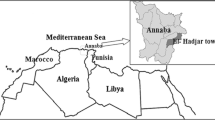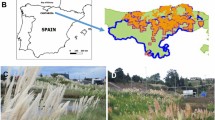Abstract
During the last years, a well documented expansion ofragweed (Ambrosia artemisiifolia L., Ambrosia trifida L.) over the Mediterranean andtemperate Europe has been in progress. The currentdistribution of ragweed plants in the Czech Republicis summarized and the ragweed pollen concentration asmonitored by 12 pollen stations in the country isdiscussed. The present situation in the ragweed pollensensitization among children and adults with pollenallergy in Brno is described. So far no dangerousexpansion of ragweed plants in our country has beenobserved. Ragweed pollen concentration is occasionallysignificant in the Brno station only, other pollenstations are reporting insignificant amounts ofragweed pollen during August-September periods,although there has been a steady increase in ragweedpollen concentration in the Prague area over the lastfive years. Skin prick tests and/or specific IgEmeasurements with ragweed allergen were performed on94 children with pollen allergy in the Brno region in1995 and on 206, 210 and 229 adult allergic patientsin 1995, 1996 and 1997, respectively. Positive skinreaction or positive specific IgE to ragweed was foundin 22% children and in 25% (1995), 19% (1996) and 25% (1997) adults with pollen allergy. It isconcluded that ragweed does not seem to represent anyimminent major threat to the allergic population inthe Czech Republic until now, however, it remains apotentially very dangerous allergen.
Similar content being viewed by others
References
AA: 1995, Methodology for routinely performed monitoring of airborne pollen-recommendations. Aerobiologia 11, 69.
D'Amato G. et al.: 1998, Pollen-related allergy in Europe. Allergy 53(6), 567-578.
Dostál J.: 1989, Nová kv¡etena ¡ CSSR 2 (The new flora of Czechoslovakia, part 2). Academia, Praha, 1548 pp.
Hejný S., Jehlík V., Kopecký K., Kropá¡c Z. and Lhotská M.: 1973, Karanténní plevele ¡ Ceskoslovenska (Quarantine weeds of Czechoslovakia). Studie CSAV. Academia, Praha, 156 pp.
Hrubiško M.: 1998, Polinóza-aktuálny problém aj v XXI. storo¡cí. ¡ Cast' III: poradie a skrížené reaktivity alergénnych druhov stromov, tráv a bylín podl'a ich klinického významu (Pollinosis-actual problem also in the XXIst century. Part III: Sequence and cross reactivity of pollinotic trees, grasses and weeds according to their clinical importance). Klinická imunológia a alergológia 2, 9-17.
Járai-Komlódi M. and Juhász M.: 1993, Ambrosia elatiorL. in Hungary (1989-1990). Aerobiologia 9, 75-78.
Jehlík V. et al.: 1998, Cizí expanzivní plevele ¡ Ceské republiky a Slovenské republiky (Alien expansive weeds of the Czech Republic and the Slovak Republic). Academia, Praha, 506 pp.
Kubátová D.: 1994, Ambrosia artemisiifoliaa Iva xanthifolia (Ambrosia artemisiifoliaand Iva xanthifolia). Severo¡ceskou P´rirodou, Litome´rice 28, 87.
Nilsson S. and Spieksma, F.T.M. (eds.): 1994, Allergy Service Guide in Europe. Stockholm, Swedish Museum of Natural History, p. 92.
Author information
Authors and Affiliations
Corresponding author
Rights and permissions
About this article
Cite this article
Rybníček, O., Novotná, B., Rybníčkova, E. et al. Ragweed in the Czech Republic. Aerobiologia 16, 287–290 (2000). https://doi.org/10.1023/A:1007611715820
Issue Date:
DOI: https://doi.org/10.1023/A:1007611715820




